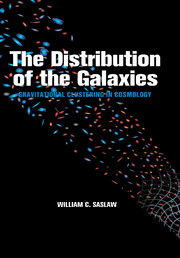Book contents
- Frontmatter
- Contents
- Prologue
- Part I Historical
- Part II Descriptions of Clustering
- 8 Patterns and Illusions
- 9 Percolation
- 10 Minimal Spanning Trees
- 11 Topology
- 12 Fractals
- 13 Bound Clusters
- 14 Correlation Functions
- 15 Distribution Functions
- Part III Gravity and Correlation Functions
- Part IV Gravity and Distribution Functions
- Part V Computer Experiments for Distribution Functions
- Part VI Observations of Distribution Functions
- Part VII Future Unfoldings
- Bibliography
- Index
10 - Minimal Spanning Trees
Published online by Cambridge University Press: 19 January 2010
- Frontmatter
- Contents
- Prologue
- Part I Historical
- Part II Descriptions of Clustering
- 8 Patterns and Illusions
- 9 Percolation
- 10 Minimal Spanning Trees
- 11 Topology
- 12 Fractals
- 13 Bound Clusters
- 14 Correlation Functions
- 15 Distribution Functions
- Part III Gravity and Correlation Functions
- Part IV Gravity and Distribution Functions
- Part V Computer Experiments for Distribution Functions
- Part VI Observations of Distribution Functions
- Part VII Future Unfoldings
- Bibliography
- Index
Summary
What! Will the line stretch out
to the crack of doom?
ShakespeareTrees are the earth's endless effort
to speak to the listening heaven.
TagoreVisual impressions of filamentary structure in the distribution of galaxies are easy to find, as Figure 8.1 and Chapter 8 with its caveats showed. Percolation statistics provide an objective basis for their existence. Minimal spanning trees characterize filaments in an even more refined but less physical way.
A set of points, each of which may represent a galaxy, can be connected by line segments in various ways. Each figure of this sort is called a graph, and the points are its vertices. The connecting segments, which may be straight or curved, are called edges. If every vertex is connected to every other vertex by some sequence of edges (i.e., a route) the graph is said to be “connected.” It may contain circuits, which are closed routes that return to their initial vertex. But if it does not have any circuits, it is a tree. A collection of trees, which need not be connected, forms a forest.
A spanning tree connects all the vertices in the set being considered. Each edge of the spanning tree can be characterized by a property such as its length, or its relative or absolute angle, or the ratio of its length to the length of its neighboring edges, or some weighted combination of properties.
- Type
- Chapter
- Information
- The Distribution of the GalaxiesGravitational Clustering in Cosmology, pp. 80 - 84Publisher: Cambridge University PressPrint publication year: 1999



